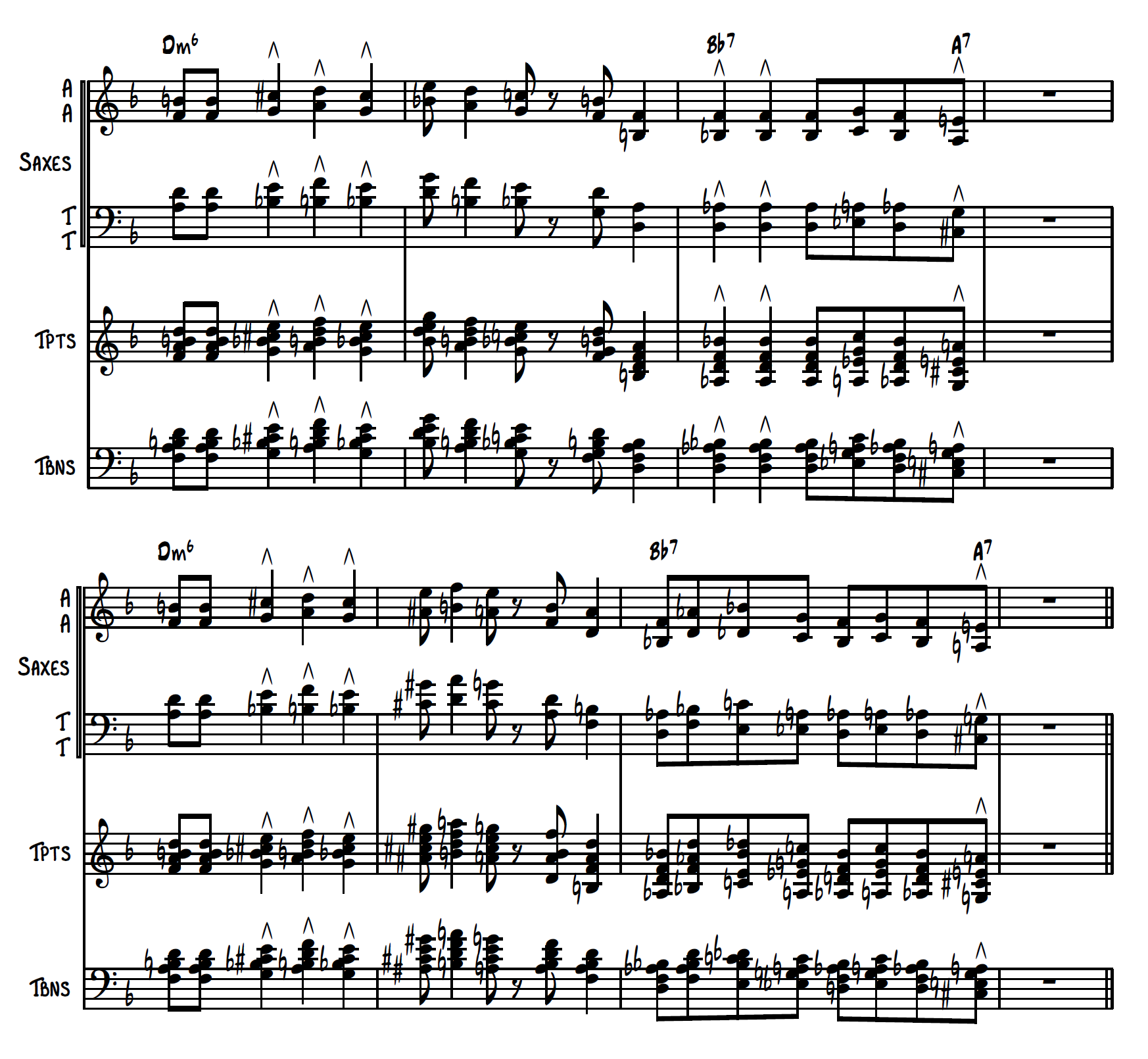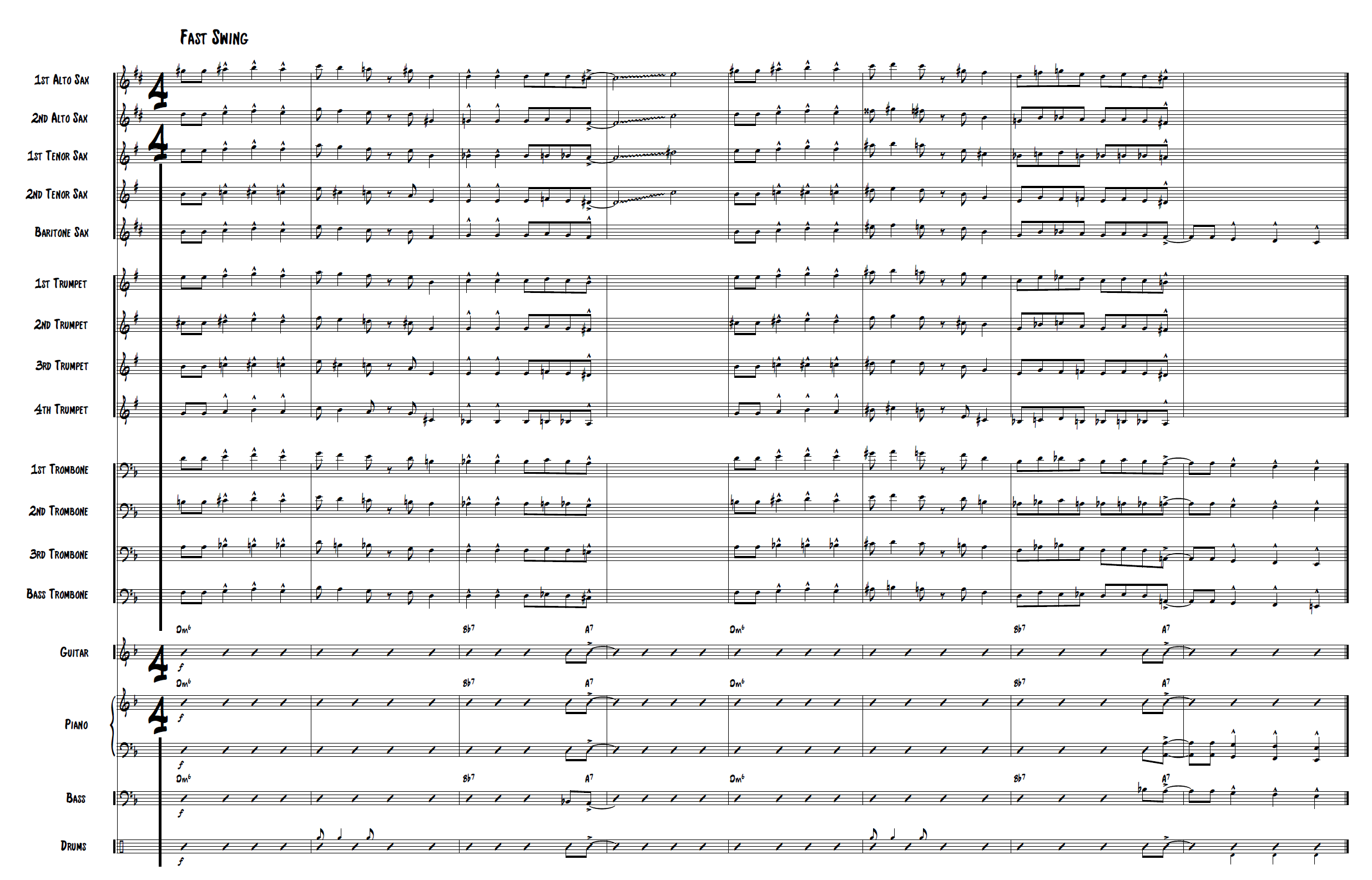15 | The Shout Chorus
The term ‘shout chorus’ has come up a lot and so far I’ve only really made a half-hearted attempt to explain exactly what it is and what’s going on. A shout chorus is traditionally the pinnacle of the big band chart. It’s a tutti where the whole band plays together, usually developing the themes, motifs and harmony that came before it. It’s high-energy and usually happens about 2/3rds of the way through a chart. In more modern charts, a shout chorus doesn’t have to be the whole band and is often more subdued. I guess making it too subdued kind of loses the effect of the ‘shout’, but the principal remains: it’s the climax.
So far, we’ve looked at soli writing and using spread voicings. A shout chorus is essentially a mixture of both of these techniques and applying it to the whole band. Similarly to how I looked at soli writing, here’s a step-by-step breakdown to arranging the shout chorus.
1. WRITE THE LEAD LINE
This could be a development of the main melody, or completely fresh material. Let’s take this simple lead and put it on trumpets. I’ve started with the trumpets because the Lead will always be playing our melody in a shout. I’m careful to put the Lead Trumpet in a good range and try to choose a key that’s good for the whole band.
2. HARMONISE THE LINE
Exactly as we did when arranging the soli, I harmonise the target notes first and then the approach notes with respect to the harmony. I use mainly four-way close and drop-2 voicings to achieve this. The most important thing is lead line clarity. Knowing that the voicings will be expanded to the whole band, I try not to have too many crunchy chords at this point.
3. LINK THE SECTIONS
So we’ve got the trumpets, but we need to add saxes and probably trombones too. Having multiple instruments play the same part brings with it balance considerations. Some books, like The Study of Orchestration (Adler) call different instruments playing the same part ‘coupling’. In other books, it gets called ‘doubling’ and the usage of both becomes ambiguous. To avoid all doubt, I’m going to call different instruments playing the same part ‘linking’.
Taking our harmonised shout for four trumpets, one thing we do not want to do is to blindly copy-and-paste the trumpet parts onto the saxes:
This results in Trumpet 1 linking with Alto 1, Trumpet 2 with Alto 2 etc. One Lead player on a melody is usually enough and in some cases (although not here) the Lead trumpet can push the Alto 1 too high to balance well. It also restricts the Lead Trumpets freedom with interpretation as they’ll have to work with Alto 1 to create a unified approach to the melody.
Instead, we can do one of two things:
Link Trumpet 2, 3 or 4 with Alto 1 depending on range.
Double the Lead trumpet down an octave in Alto 1.
Linking Trumpet 2, 3, or 4
The first option is quite a thick sound, but works well if the range of the line is low in the trumpets:
You can also create an Alto 1 line from scratch using any notes from the Trumpet soli to create the most melodic voice leading possible. When the chart is slow, or the Lead Trumpet is low, Alto 1 can double the Lead Trumpet, but I’d advise rearranging the sax voicings so it’s not a complete copy-paste of the trumpet parts to avoid a metallic, phasing sound - if the trumpets are in close voicing, try the saxes in open and vice versa.
Notice that once Alto 1 is linked with Trumpet 2, 3 or 4, the saxes below are harmonised from scratch.
I don’t simply copy-and-paste the other trumpet lines to the remaining saxes. Instead, care is taken in the saxes to harmonise the target notes first, and then the approach notes are dealt with, the same way the trumpet soli was conceived. The only difference is that we’re treating the Alto 1 line as the melody now. Sure, you end up with much of the same notes as if you’d copied the trumpet parts, but this ensures the parts are optimised for saxes and avoids any unwanted intervals as the saxes extend below where the trumpets left off.
This also allows us to decide on a different approach for the saxes than we had for trumpets. For the trumpets, we used a lot of four-way close, but drop-2 in the saxes creates a big, open sound that is really effective a lot of the time to create clarity when a lot of instruments are playing. If you’re careful, you can also use this opportunity to add extra notes into chords, especially on dominant chords. An extra available tension in an inner sax part can make a soli interesting the second time around a phrase. If I was to add a bari part, it would probably be similar to either the bass trombone part or doubling the Alto 1 melody an octave down.
Alto Playing The Lead Trumpet 8vb
Having Alto 1 play the Lead Trumpet part down the octave is great for a strong, powerful sound. This works best under two conditions:
The Lead Trumpet is high. This leaves room for the voices to extend below it.
The trumpets are in close position or in simple triads with the Lead Trumpet and Trumpet 4 in octaves.
Ray Wright who taught jazz at the prestigious Eastman School of Music would say that as long as the saxes sound good by themselves, the brass will be fine. Make sure to have a complete voicing in the saxes that is effective on it’s own.
Here’s an example of the same shout with the saxes linked with the trumpets 8vb:
Our shout here for trumpets is a bit low to have Alto 1 underneath. The saxes just about work range-wise but we do push Tenor 2 quite low for a shout chorus. Notice in orange where the trumpet voicing is in drop-2, the Alto 1 melody gets trapped in between a couple of notes and gets a bit muddy.
With that in mind, let’s use the first option, linking Alto 1 to Trumpet 2. Here’s the shout with saxes and trumpets so far:
Let’s recap that linking method:
Take a shout, harmonised in trumpets.
Decide the linking method. We can use Trumpet 2, 3 or 4 as the Alto 1 line, depending on range and thickness desired; use the Lead Trumpet part 8vb or Alto 1; or create one from scratch.
Harmonise the saxes using Alto 1 as the new melody. (I recommend drop-2 voicings in the saxes for this to create an open, strong sound).
What about the trombones?
The trombones can be dealt with one of two ways:
Treat them like extra trumpets and just extend the trumpet voicing downwards.
Link the Lead Trombone to another line like we did with Alto 1 and harmonise downwards.
It all depends on range. If the first option pushes the Lead Trombone too low (it should be hanging around just above the stave) then try option 2. Drop-2 and drop-2/4 voicings are often clearer in the trombones. Just make sure that the trombones don’t dip too low. Having them in close harmony in the lower half of the bass stave is a very thick sound.
Here are the trombones with the trumpet voicing extended downwards, creating a traditional big band shout chorus with everyone playing together:
In the second audio example here I’ve just shown the trumpets and trombones. This way you can hear how the trombones are just extensions of the trumpet voicing - almost like having big 8-part chords. Because no inner notes are doubled by the saxes, it’s a cleaner, more direct sound. The trombone lines in the penultimate bar at this tempo can be tricky to pull off cleanly, but in a full shout chorus, any difficulty gets hidden with decent players.
Here’s the second option with trombones providing interjections rather than doubling the melody:
4. WRITE THE RHYTHM SECTION PARTS
In reality, I probably would have done this much earlier based on the melody and harmony sketch. If you’ve got to this point, these parts write themselves. I won’t talk about it too much here because I have a whole article on rhythm section writing that you can find here. I’ve kept it simple overall with just a few kicks in the drums. Notice that I specify the octave for the bass going into the A7 chord so it remains the bottom of the chord.
Here’s the 8-bars we’ve done, finalised with a mixture of the approaches from above:
Tension and Release
As mentioned before in my article on spread voicings, tension and release is everything. In the case of the shout chorus though, that tension is often rhythmic. Great shouts set up expectations by using the same structure as the theme for example, but before big, climatic target notes, introduce an extra few bars or a drum fill to build tension.
Techniques like this, and even simpler ones (like delaying impactful notes by just a beat) can have a big effect on the arrangement.
REAL LIFE EXAMPLE
So that’s the theory. There are a ton of great shout choruses out there to gain inspiration from. Let’s analyse one. I’m going to pick one of my favourites: Gordon Goodwin’s adaptation of Mozart’s 40th Symphony in G minor. It’s a modern chart, but written in a traditional way with a really nicely developed shout chorus.
I’d recommend listening a few times first. The first A section consists of the main theme that happens from 00:10-00:47 and the shout chorus I’m going to break down is from 6:08-6:48 where Goodwin transitions into swing. Notice the shout chorus developing the ideas from the A section as well as providing a climax for the chart.
Goodwin’s version of the theme is as follows:
Here’s the shout chorus which is developed from that theme:
Notice that in this shout chorus, the trumpets are quite high and often in simple triads with Trumpet 4 doubling the Lead down an octave. The voicing is then extended down through the saxes and the trombones double the saxes. This creates a very clean, open sound if you have trumpets that can handle the upper register.
The bari sax also works very independently throughout, often going below the trombones. I’ve often called sax voicings four-way close, ignoring what the bari is doing.
That’s just one great example but writing an effective shout chorus is a key part of any big band arranger’s repertoire. Next I’ll be looking at improvised solos and their place in big band arrangements.













